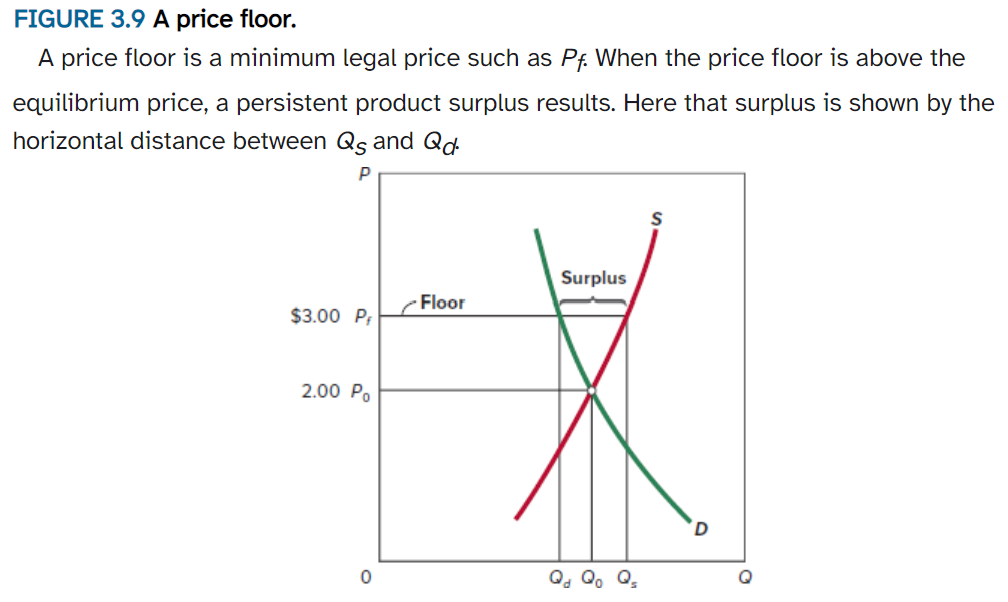microeconomics flashcards + summaries
1/80
Earn XP
Description and Tags
Name | Mastery | Learn | Test | Matching | Spaced |
|---|
No study sessions yet.
81 Terms
economics
The social science concerned with how individuals, institutions, and society make optimal (best) choices under conditions of scarcity.
economic perspective
A viewpoint that envisions individuals and institutions making rational decisions by comparing the marginal benefits and marginal costs associated with their actions.
scarcity
The limits placed on the amounts and types of goods and services available for consumption as the result of there being only limited economic resources from which to produce output; the fundamental economic constraint that creates opportunity costs and that necessitates the use of marginal analysis (cost-benefit analysis) to make optimal choices.
opportunity cost
The amount of other products that must be forgone or sacrificed to produce a unit of a product.
utility
The want-satisfying power of a good or service; the satisfaction or pleasure a consumer obtains from the consumption of a good or service (or from the consumption of a collection of goods and services).
marginal analysis
The comparison of marginal (“extra” or “additional”) benefits and marginal costs, usually for decision making.
scientific method
The procedure for the systematic pursuit of knowledge involving the observation of facts and the formulation and testing of hypotheses to obtain theories, principles, and laws.
economic principle
A widely accepted generalization about the economic behavior of individuals or institutions.
other-things-equal assumption
The assumption that factors other than those being considered are held constant. Also known as the ceteris paribus assumption.
microeconomics
The part of economics concerned with (1) decision making by individual units such as a household, a firm, or an industry and (2) individual markets, specific goods and services, and product and resource prices.
macroeconomics
The part of economics concerned with the performance and behavior of the economy as a whole. Focuses on economic growth, the business cycle, interest rates, inflation, and the behavior of major economic aggregates such as the household, business, and government sectors.
aggregate
A collection of specific economic units treated as if they were one unit.
positive economics
The analysis of facts or data to establish scientific generalizations about economic behavior.
normative economics
The part of economics involving value judgments about what the economy should be like; focused on which economic goals and policies should be implemented; policy economics.
economizing problem
The choices necessitated because society’s economic wants for goods and services are unlimited but the resources available to satisfy these wants are limited (scarce).
budget line
A line that shows the different combinations of two products a consumer can purchase with a specific money income, given the products’ prices.
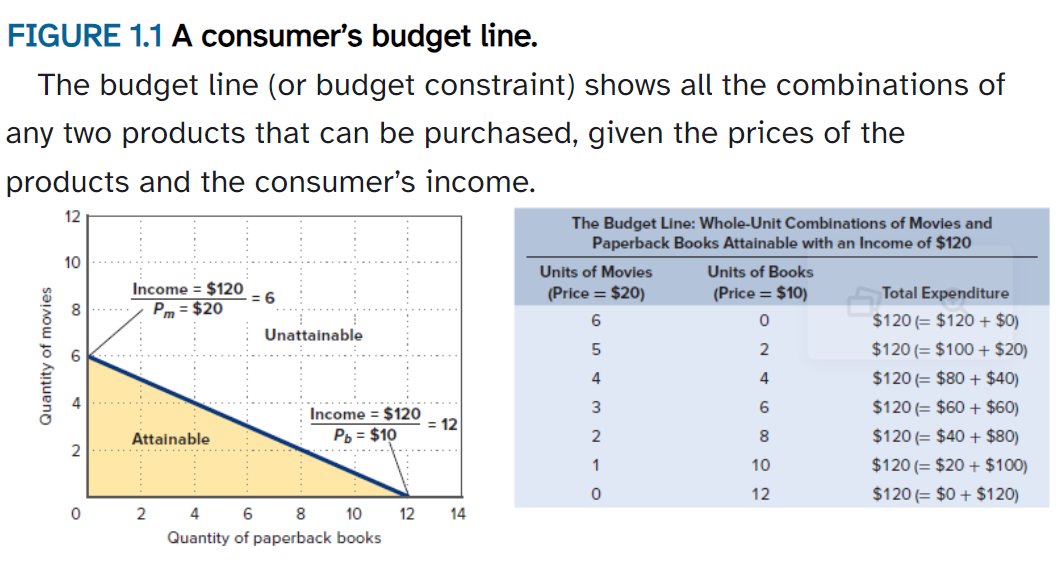
economic resources
The land, labor, capital, and entrepreneurial ability that are used to produce goods and services. Also known as the factors of production.
land
In addition to the part of the earth’s surface not covered by water, this term refers to any and all natural resources (“free gifts of nature”) that are used to produce goods and services. Thus, it includes the oceans, sunshine, coal deposits, forests, the electromagnetic spectrum, and fisheries. Note that land is one of the four economic resources.
labor
Any mental or physical exertion on the part of a human being that is used in the production of a good or service. One of the four economic resources.
capital
Man-made physical objects (factories, roads) and intangible ideas (the recipe for cement) that do not directly satisfy human wants but which help to produce goods and services that do satisfy human wants; also called capital goods. One of the four economic resources. Money is not capital because it is merely a means of exchange.
investment
Expenditures that increase the volume of physical capital (roads, factories, wireless networks) and intangible ideas (formulas, processes, algorithms) that help to produce goods and services. Also known as economic investment. Not to be confused with financial investment.
consumer goods
Products and services that satisfy human wants directly.
capital goods
Human-made resources (electrical grids, the GPS system, rail networks) used to produce goods and services; goods that do not directly satisfy human wants; also called capital. One of the four economic resources.
entrepreneurial ability
The human resource that combines the other economic resources of land, labor, and capital to produce new products or make innovations in the production of existing products; provided by entrepreneurs.
entrepeneurs
Individuals who provide entrepreneurial ability to firms by setting strategy, advancing innovations, and bearing the financial risk if their firms do poorly.
factors of production
The four economic resources: land, labor, capital, and entrepreneurial ability.
production possibilities curve
A curve showing the different combinations of two goods or services that can be produced in a full-employment, full-production economy where the available supplies of resources and technology are fixed.
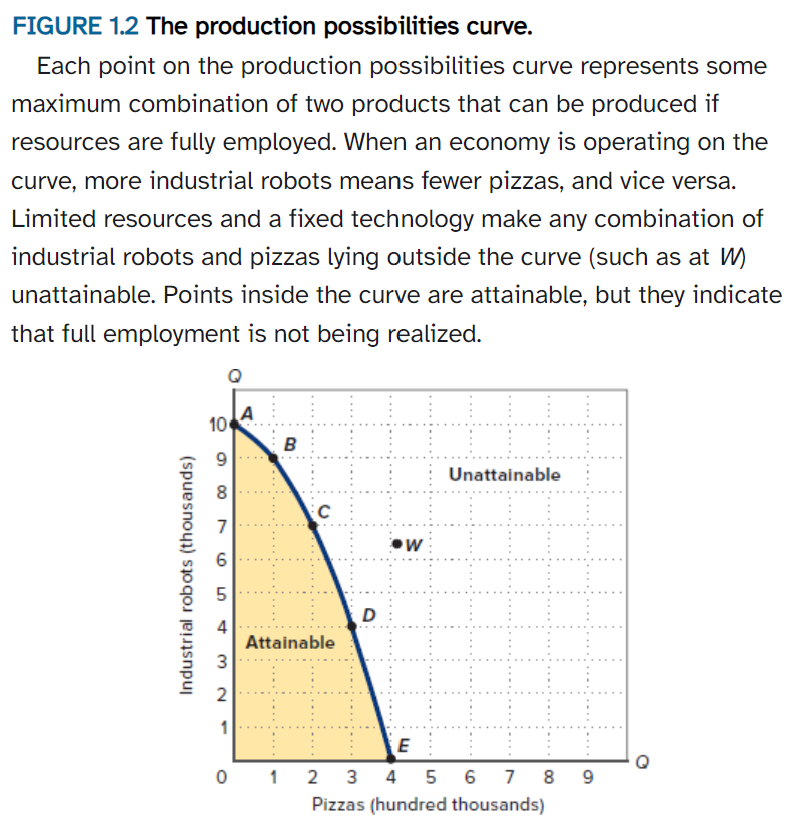
law of increasing opportunity costs
The principle that as the production of a good increases, the opportunity cost of producing an additional unit rises.
economic growth
(1) An outward shift in the production possibilities curve that results from an increase in resource supplies or quality or an improvement in technology; (2) an increase of real output (gross domestic product) or real output per capita.

optimal output
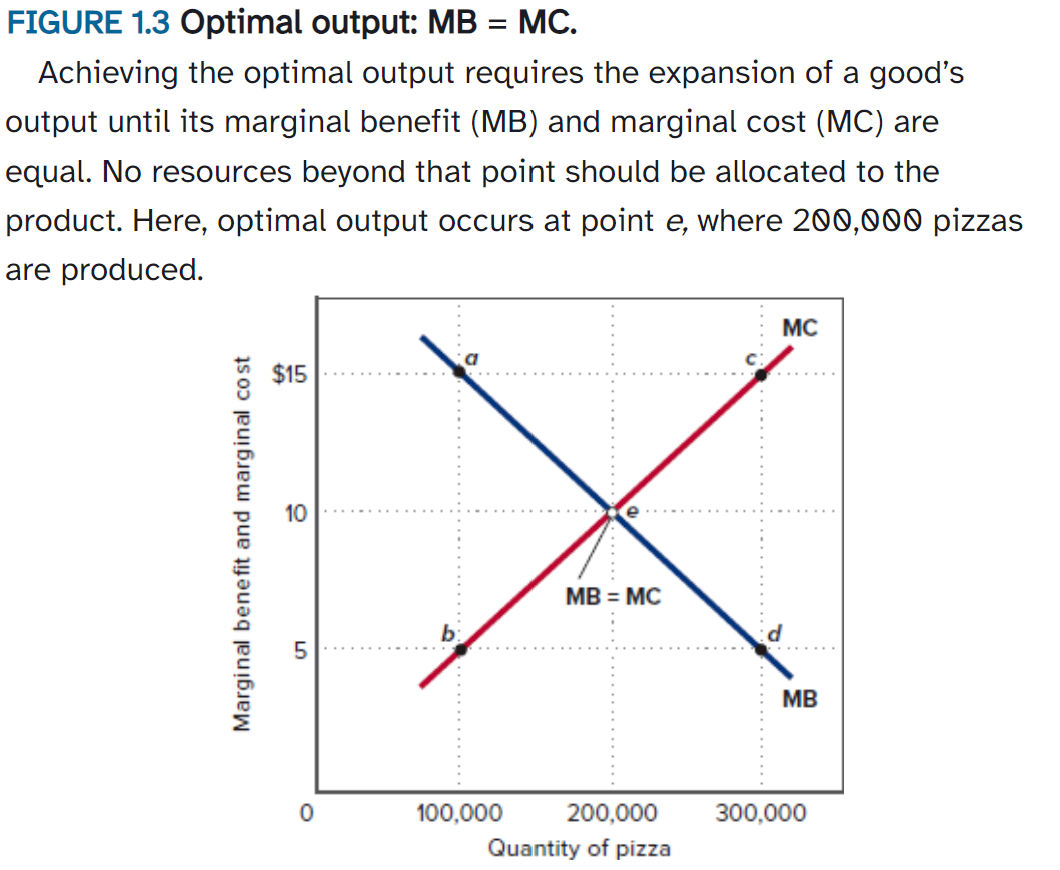
economic system
A particular set of institutional arrangements and a coordinating mechanism for solving the economizing problem; a method of organizing an economy, of which the market system and the command system are the two general types.
laissez-faire capitalism
A hypothetical economic system in which the government’s economic role is limited to protecting private property and establishing a legal environment appropriate to the operation of markets in which only mutually agreeable transactions take place between buyers and sellers; sometimes referred to as “pure capitalism.”
command system
A method of organizing an economy in which property resources are publicly owned and government uses central economic planning to direct and coordinate economic activities; socialism; communism. Compare with market system.
market system
(1) An economic system in which individuals own most economic resources and in which markets and prices serve as the dominant coordinating mechanism used to allocate those resources; capitalism. Compare with command system. (2) All the product and resource markets of a market economy and the relationships among them.
market
Any institution or mechanism that brings together buyers (demanders) and sellers (suppliers) of a particular good or service.
private property
The right of private persons and firms to obtain, own, control, employ, dispose of, and bequeath land, capital, and other property.
freedom of enterprise
The freedom of firms to obtain economic resources, to use those resources to produce products of the firms’ own choosing, and to sell their products in markets of their choice.
freedom of choice
The freedom of owners of property resources to employ or dispose of them as they see fit, of workers to enter any line of work for which they are qualified, and of consumers to spend their incomes in the manner that they prefer.
self-interest
That which each firm, property owner, worker, and consumer believes is best for itself and seeks to obtain.
competition
The effort and striving between two or more independent rivals to secure the business of one or more third parties by offering the best possible terms.
specialization
The use of the resources of an individual, a firm, a region, or a nation to concentrate production on one or a small number of goods and services.
division of labor
The separation of the work required to produce a product into a number of different tasks that are performed by different workers; specialization of workers.
medium of exchange
Any item sellers generally accept and buyers generally use to pay for a good or service; money; a convenient means of exchanging goods and services without engaging in barter.
barter
The direct exchange of one good or service for another good or service.
money
Any item that is generally acceptable to sellers in exchange for goods and services.
consumer sovereignty
The determination by consumers of the types and quantities of goods and services that will be produced with the scarce resources of the economy; consumers’ direction of production through their dollar votes.
dollar votes
The “votes” that consumers cast for the production of preferred products when they purchase those products rather than the alternatives that were also available.
creative destruction
The hypothesis that the creation of new products and production methods destroys the market power of existing monopolies.
invisible hand
The tendency of competition to cause individuals and firms to unintentionally but quite effectively promote the interests of society even when each individual or firm is only attempting to pursue its own interests.
circular flow diagram
An illustration showing the flow of resources from households to firms and of products from firms to households. These flows are accompanied by reverse flows of money from firms to households and from households to firms.
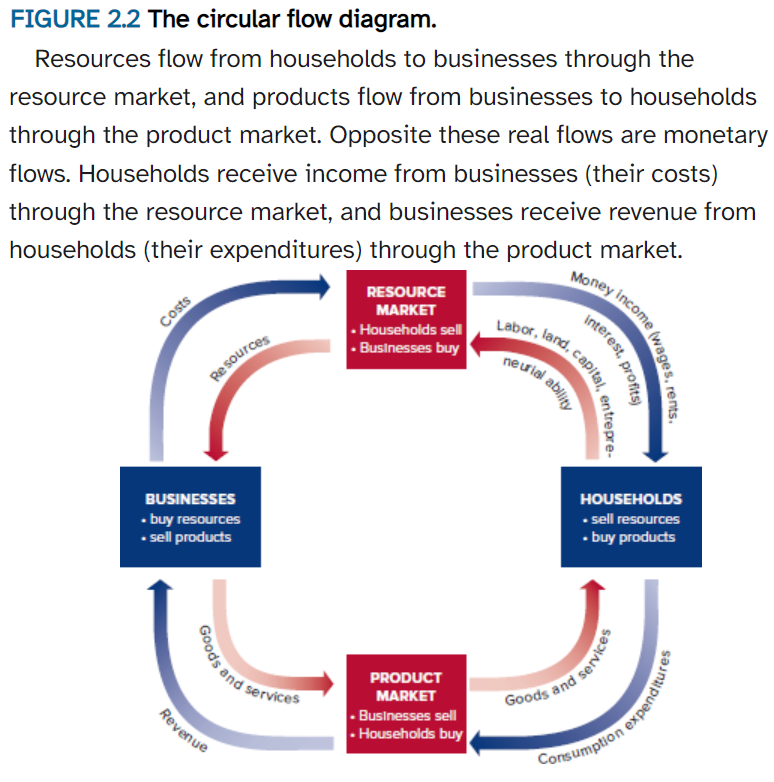
households
Economic entities (of one or more persons occupying a housing unit) that provide resources to the economy and use the income received to purchase goods and services that satisfy economic wants.
businesses
Economic entities (firms) that purchase resources and provide goods and services to the economy.
businesses: sole proprietorship / partnership / corporation
businesses: Economic entities (firms) that purchase resources and provide goods and services to the economy.
sole proprietorship: An unincorporated firm owned and operated by one person.
partnership: An unincorporated firm owned and operated by two or more persons.
corporation: A legal entity (“person”) chartered by a state or the federal government that is distinct and separate from the individuals who own it.
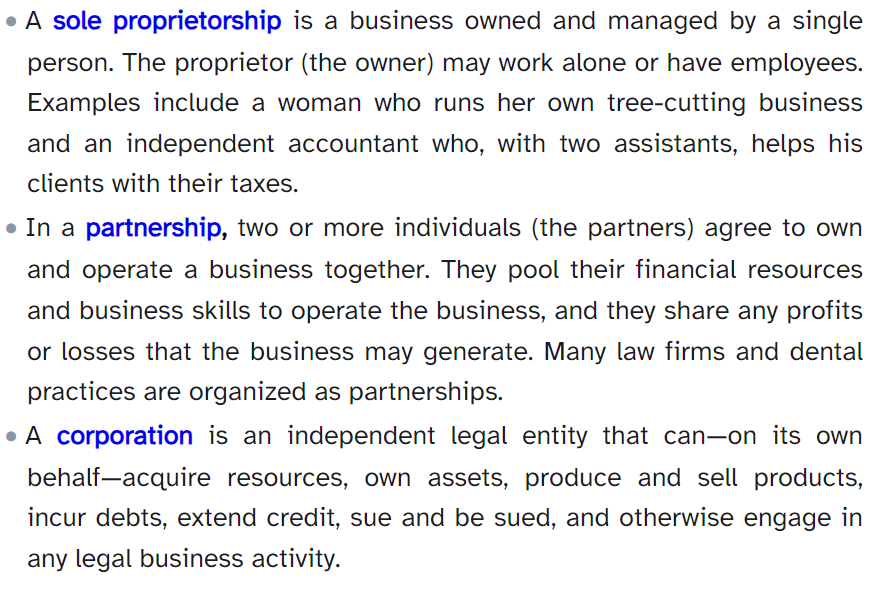
product market
A market in which products are sold by firms and bought by households.
resource market
A market in which households sell and firms buy resources or the services of resources.
residual claimant
In a market system, the economic agent who receives (is claimant to) whatever profit or loss remains (is residual) at a firm after all other input providers have been paid. The residual is compensation for providing the economic input of entrepreneurial ability and flows to the firm’s owners.
demand
A schedule or curve that shows the various amounts of a product that consumers are willing and able to purchase at each of a series of possible prices during a specified period of time.
demand schedule
A table of numbers showing the amounts of a good or service buyers are willing and able to purchase at various prices over a specified period of time. (blue table on right of image)
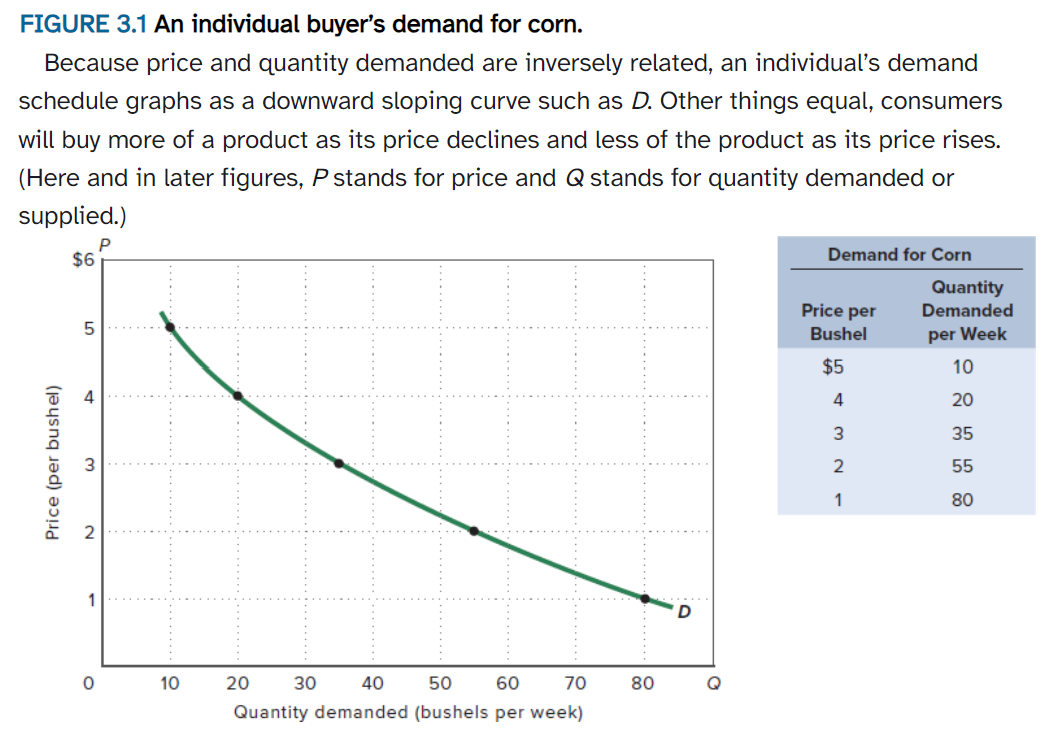
law of demand
The principle that, other things equal, an increase in a product’s price will reduce the quantity of it demanded, and conversely for a decrease in price.
diminishing marginal utility
The principle that as a consumer increases the consumption of a good or service, the marginal utility obtained from each additional unit of the good or service decreases.
income effect
A change in the quantity demanded of a product that results from the change in real income (purchasing power) caused by a change in the product’s price.
substitution effect
(1) A change in the quantity demanded of a consumer good that results from a change in its relative expensiveness caused by a change in the good’s own price.
(2) The reduction in the quantity demanded of the second of a pair of substitute resources that occurs when the price of the first resource falls and causes firms that employ both resources to switch to using more of the first resource (whose price has fallen) and less of the second resource (whose price has remained the same).
demand curve
A curve that illustrates the demand for a product by showing how each possible price (on the vertical axis) is associated with a specific quantity demanded (on the horizontal axis). (graph on the left of the image)
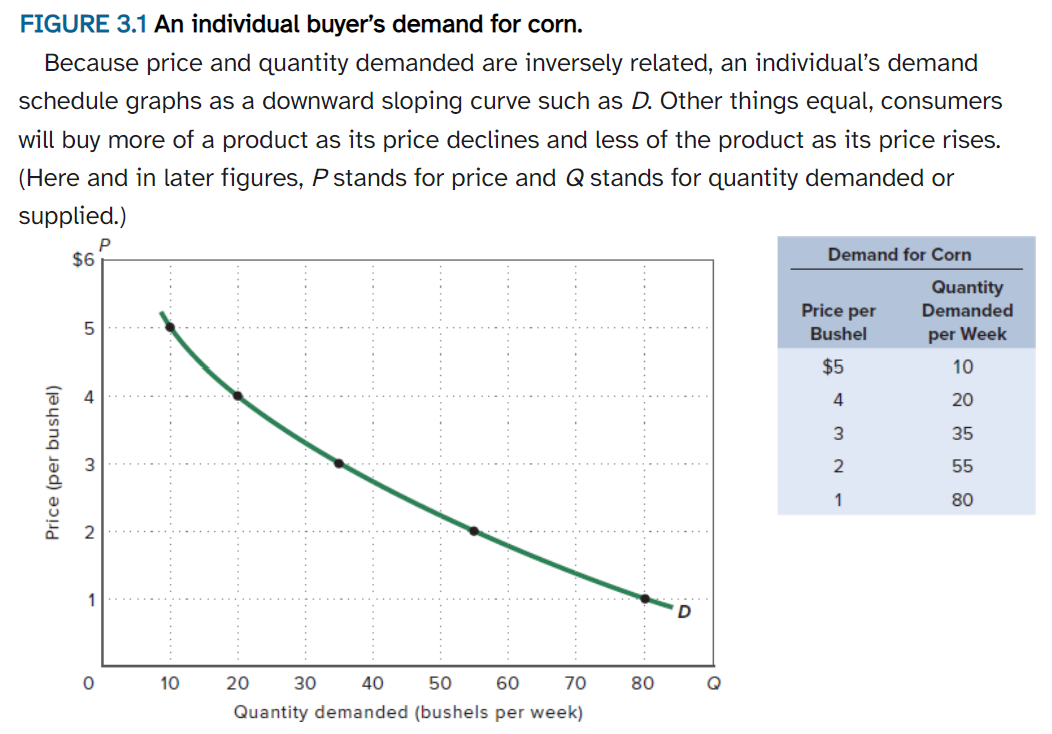
determinants of demand
Factors other than price that determine the quantities demanded of a good or service. Also referred to as “demand shifters” because changes in the determinants of demand will cause the demand curve to shift either right or left.
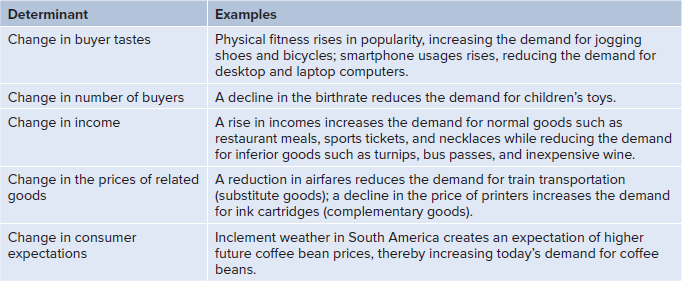
types of good
normal good: A good or service whose consumption increases when income increases and falls when income decreases, price remaining constant.
inferior good: A good or service whose consumption declines as income rises, prices held constant.
substitute goods: Products or services that can be used in place of each other. When the price of one falls, the demand for the other product falls; conversely, when the price of one product rises, the demand for the other product rises.
complementary goods: Products and services that are used together. When the price of one falls, the demand for the other increases (and conversely).
change in demand
A movement of an entire demand curve or schedule such that the quantity demanded changes at every particular price; caused by a change in one or more of the determinants of demand.
supply
A schedule or curve that shows the various amounts of a product that producers are willing and able to make available for sale at each of a series of possible prices during a specified period of time.
supply schedule
A table of numbers showing the amounts of a good or service producers are willing and able to make available for sale at each of a series of possible prices during a specified period of time. (table on the right of image)
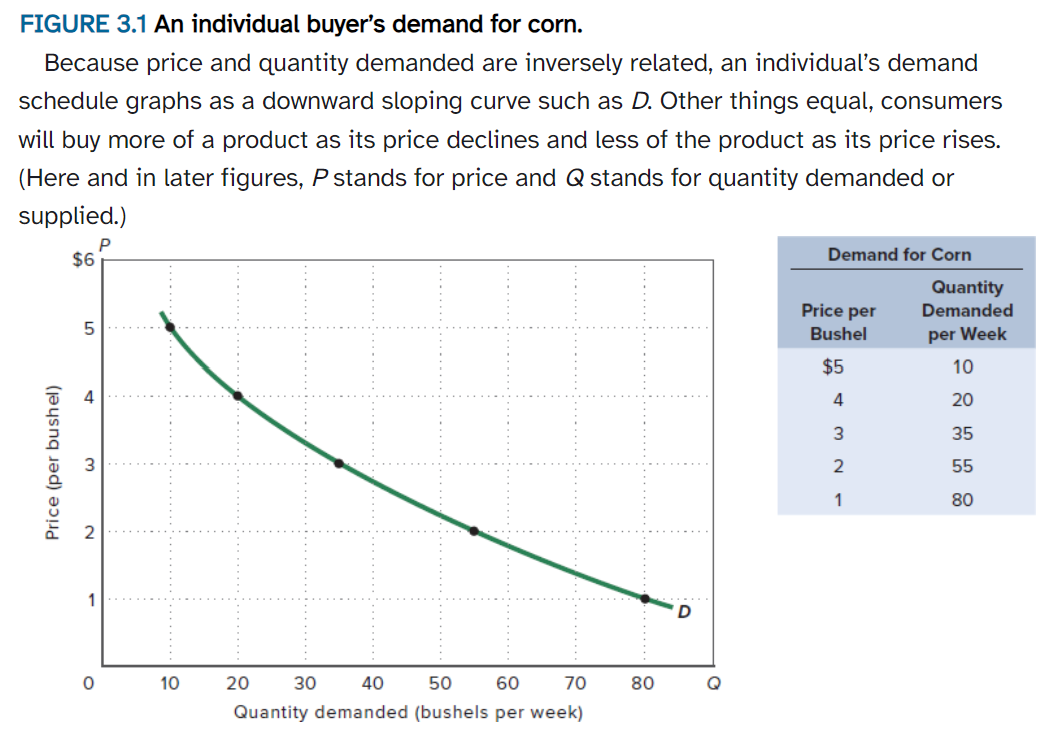
law of supply
The principle that, other things equal, an increase in the price of a product will increase the quantity of it supplied, and conversely for a price decrease.
supply curve
A curve that illustrates the supply for a product by showing how each possible price (on the vertical axis) is associated with a specific quantity supplied (on the horizontal axis). (graph on the left of image)
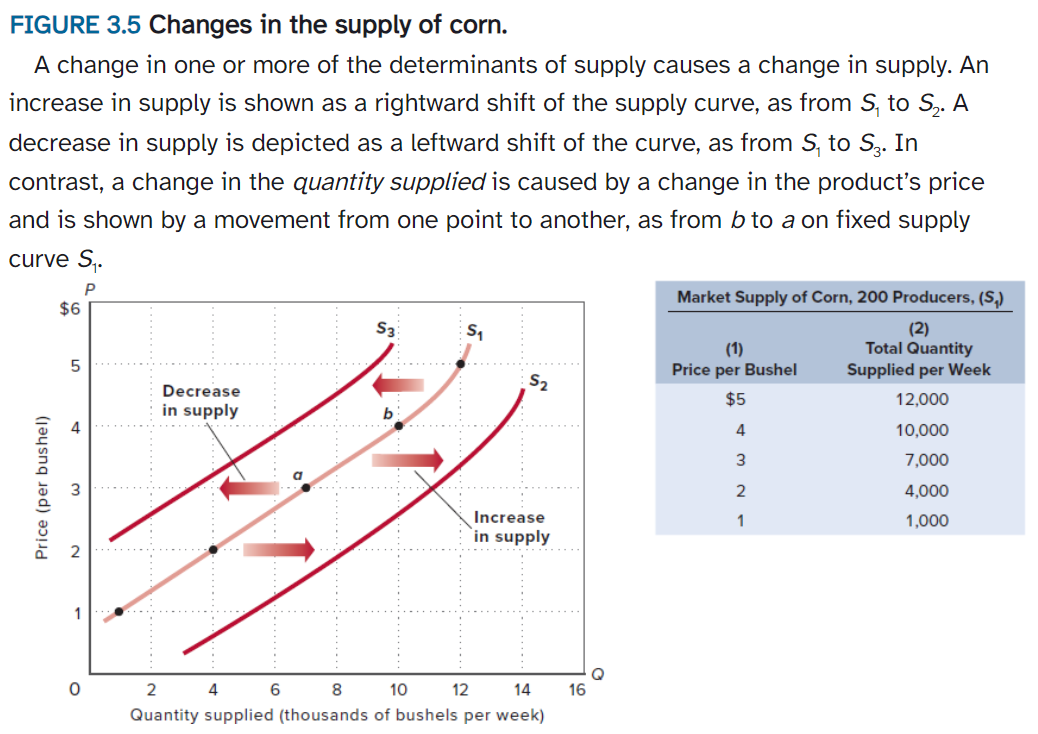
determinants of supply
Factors other than price that determine the quantities supplied of a good or service. Also referred to as “supply shifters” because changes in the determinants of supply will cause the supply curve to shift either right or left.
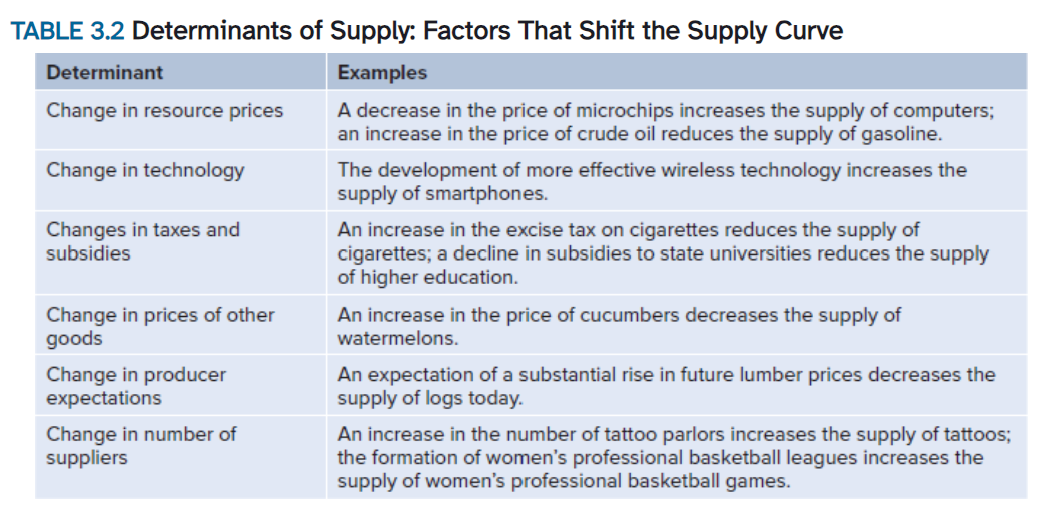
change in supply
A movement of an entire supply curve or schedule such that the quantity supplied changes at every particular price; caused by a change in one or more of the determinants of supply.
change in quantity supplied
A change in the quantity supplied along a fixed supply curve (or within a fixed supply schedule) as a result of a change in the product’s price.
equilibrium price
The price in a competitive market at which the quantity demanded and the quantity supplied are equal, there is neither a shortage nor a surplus, and there is no tendency for price to rise or fall.
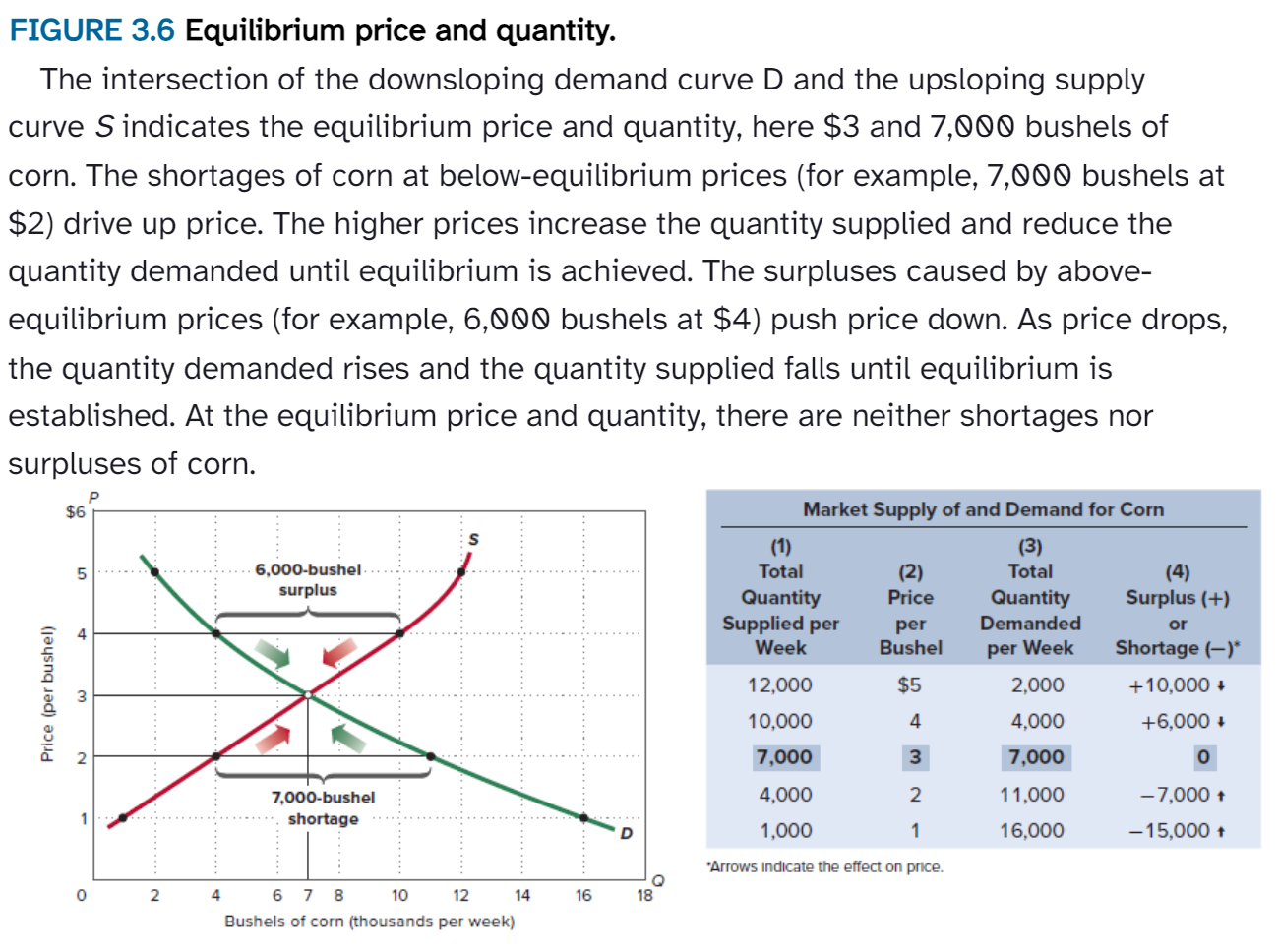
equilibrium quantity
(1) The quantity at which the intentions of buyers and sellers in a particular market match at a particular price such that the quantity demanded and the quantity supplied are equal;
(2) the profit-maximizing output of a firm.
surplus
The amount by which the quantity supplied of a product exceeds the quantity demanded at a specific (above-equilibrium) price.
shortage
The amount by which the quantity demanded of a product exceeds the quantity supplied at a particular (below-equilibrium) price.
productive efficiency
The production of a good in the least costly way; occurs when production takes place at the output at which average total cost is a minimum and marginal product per dollar’s worth of input is the same for all inputs.
allocative efficiency
The apportionment of resources among firms and industries to obtain the production of the products most wanted by society (consumers); the output of each product at which its marginal cost and price or marginal benefit are equal, and at which the sum of consumer surplus and producer surplus is maximized.
price ceiling
A legally established maximum price for a good, or service. Normally set at a price below the equilibrium price.
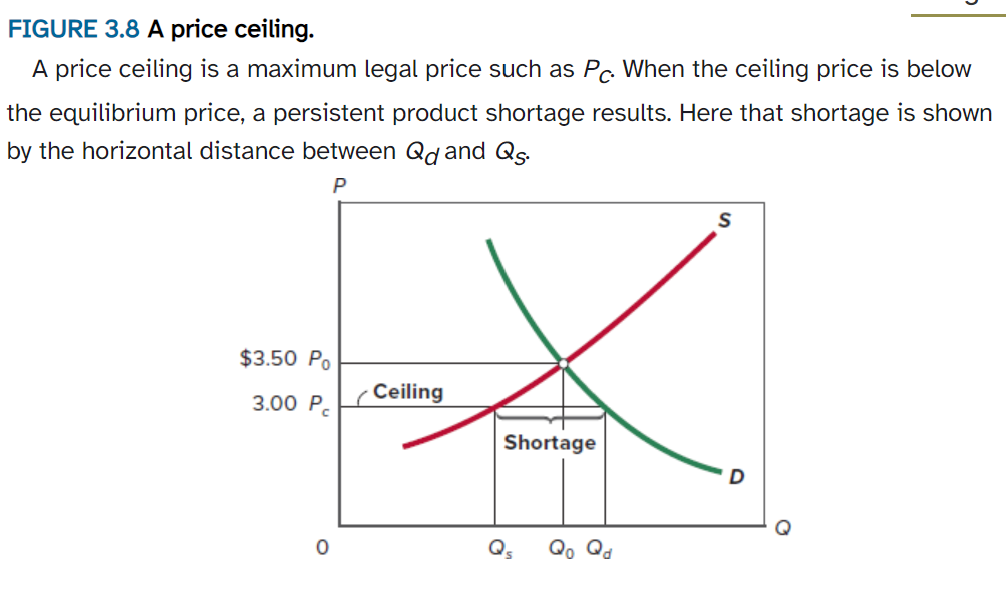
price floor
A legally established minimum price for a good, or service. Normally set at a price above the equilibrium price.
